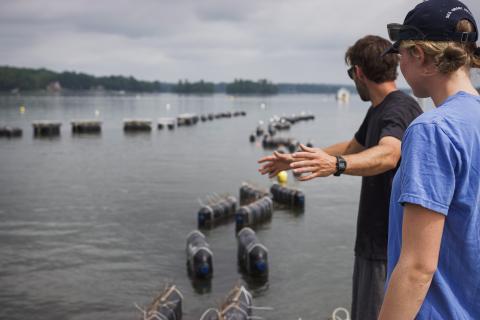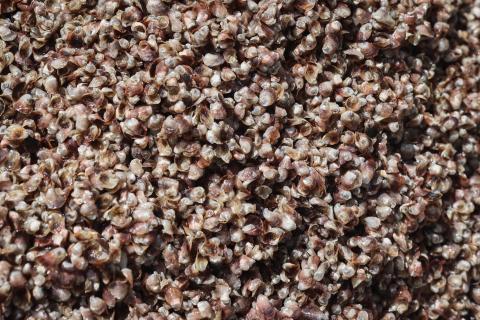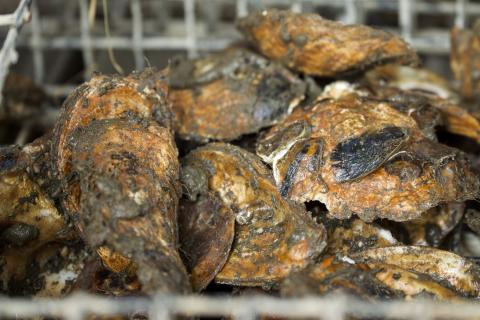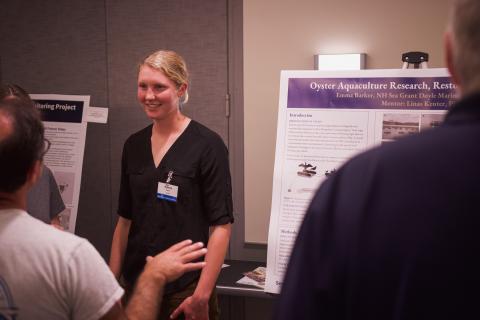Sea Grant Fellow Reflects on Collaborative Oyster Conservation and Farming in Great Bay
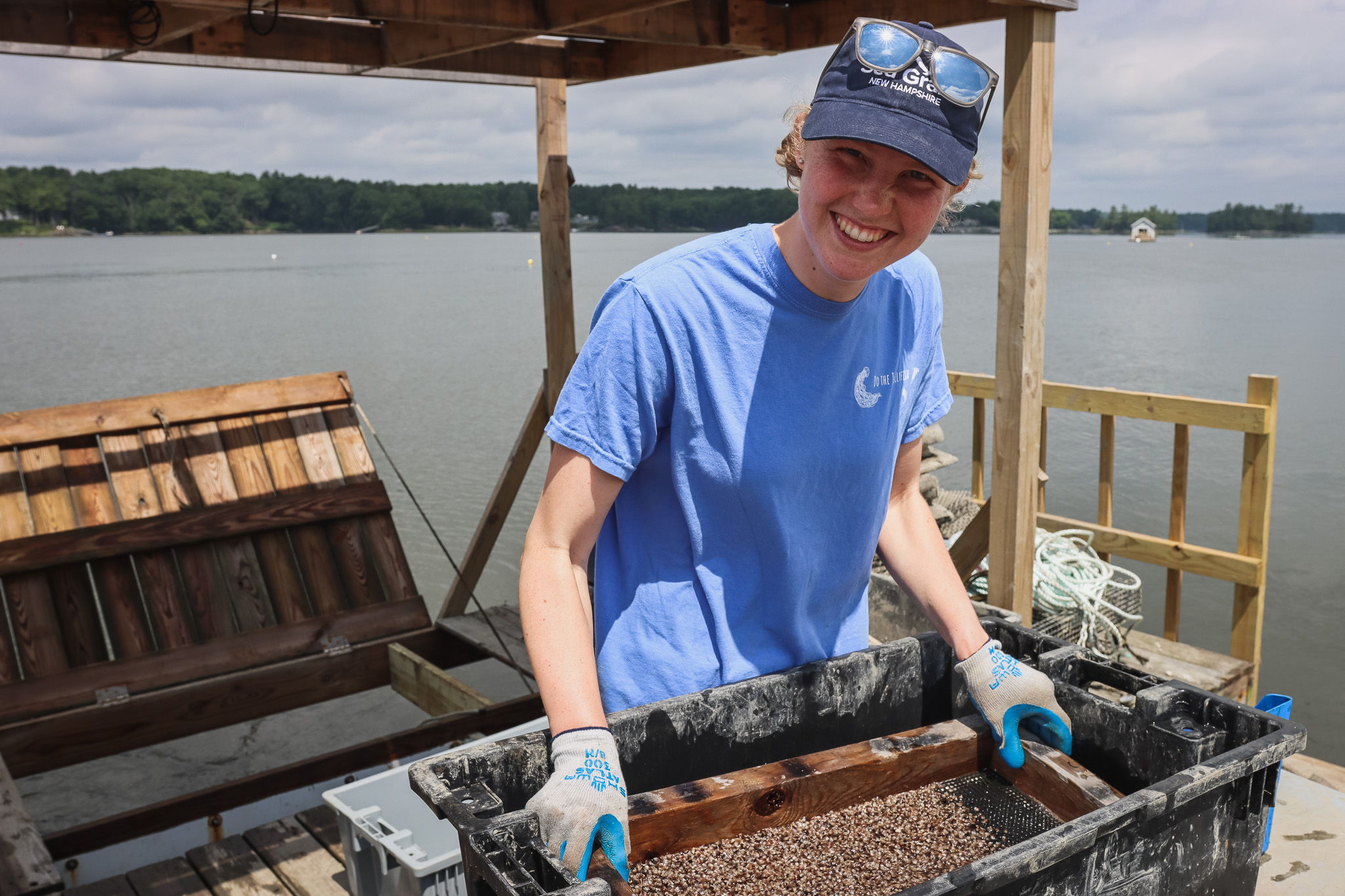
Emma Barker is an undergraduate student at Bowdoin College, who spent this summer working as a Doyle Fellow with New Hampshire Sea Grant. Her project was titled Estuarine Aquaculture Research, Restoration, and Extension, and the following are Emma's reflections from her time working in New Hampshire's Great Bay estuary.
An Industry Embracing Restoration
It's the kind of day that makes everyone want to be an oyster farmer – a cool, sunny 'Fun Friday', which is the weekly session dedicated to random tasks on Wagon Hill Oyster Farm.
The farm manager, Evan, reads to us from a little yellow Rite-in-the-Rain notebook:
"Sunny and 68 degrees, no cloud cover. Removed 4 green crabs, biofouling, and sediment from cages."
Evan has just cruised across Great Bay in the farm skiff to pick up 15, 1- by 2-foot cages filled with recycled shells. But these aren't just any shells, they're speckled with tender, rust-colored baby oysters from The Nature Conservancy (TNC). Next, we’ll pour the chalky shell into wire trays on the estuary’s bottom, where the babies will grow through the summer under Evan’s watchful eye, their progress recorded in his little journal.
Most of the time, this farm isn’t growing spat-on-shell, but rather individual oysters for eating—the kind you might find fried, served as Oysters Rockefeller, or freshly shucked at a local raw bar. But this annual spat-on-shell delivery is part of an exciting collaboration amongst a network of stakeholders in Great Bay that helps make it possible for the Granite State to simultaneously eat more oysters, and boost their natural populations in the estuary, too.
As a Sea Grant Fellow in aquaculture research, restoration, and extension this summer, I’ve been lucky to witness the whole range of oyster activity happening in Great Bay through my work, from farming oysters to rebuilding reefs. My favorite part of the job is watching these projects overlap and complement each other. I love this model for how aquaculture and wild populations can align, to mutual benefit. It truly connects farmers, businesspeople, community members, and conservationists, putting them in conversation with each other. Harnessing these alliances, I’m learning, holds particular promise in the ongoing work to bolster healthy coastal communities, both natural and human.
So, Why Oysters?
Oh, I’m so glad you asked! Oysters, like many other two-shelled aquatic animals, are 3-inch long superheroes, bridging economic power and ecosystem services. They provide enormous value to human and natural systems alike by improving water quality and habitat availability in estuarine environments. Estuaries, places where fresh and saltwater meet, serve as nurseries for much of the ocean’s life. Meanwhile, oyster production for food has nearly doubled over the past decade, reflecting a healthy market for these critters and supporting upwards of 1,500 mostly small-scale farms along the East Coast.
Sound familiar? I’d say that’s Sea Grant’s mission in a nutshell – to build thriving coastal communities, ecosystems, and economies of healthy people and wildlife. And the oyster weaves them all together.
How to Build a Reef: The Ins and Outs of Oyster Restoration
Here in Great Bay, the basic model for oyster restoration is pretty simple:
- Identify where reefs existed historically.
- Build those locations up with recycled shells to provide substrate for new oysters.
- Seed the recycled shells with live oysters.
However, this process requires significant labor.
I jumped in to lend a hand on a sweltering day in early July, just after TNC had received its second batch of restoration oyster larvae for the year. Prior to deployment, these six million tiny, free-swimming larvae had settled onto shells in TNC’s on-land tanks, metamorphosing into “spat.” This year’s operation was declared a wild success, with counts revealing some shells covered in upwards of 100 tiny oysters. As a volunteer crew, we hung these cages off of floating docks, where they're protected from most predators and receive a steady flow of phytoplankton food for the weeks before they go out to the reef.
Maximizing oyster survival takes significant care, and it’s the work to get the tiny oysters large enough to survive on a wild reef that brings in a whole lot of collaboration.
It Takes a Village
Oyster farms like Wagon Hill Oysters have the gear and space to take many of these baby oysters and grow them for the summer season. They add capacity beyond what the individual oyster conservation volunteers can accomplish, who care for single cages off private docks and moorings around Great Bay.
In the fall, all of these oyster nurturers return their wards to TNC, who deploys the oysters out to join the existing restoration sites they’ve been working on since 2009.
Even with all these folks working together to raise spat, restoration efforts can use more oysters.
I learned how the gap gets filled early this summer while sorting oysters for market at Virgin Oyster Company, armed with rings of 3-inch PVC pipe for reference. A deep cup, teardrop shape, gently upturned hinge, and shell length between 2.5 and 3.5 inches sent an oyster into the green bucket labeled “markets.” Shorter than that, and it was labelled as “sub,” plunking into the blue bucket. Longer, or with a reverse hinge or the checkered marks of a shell grown into the sides of the bag? Off to the white “restoration” bucket. These are “uglies,” destined for a long, happy life in the reef. And that restoration bucket gets pretty full – in 2024, 50% of the oysters harvested by New Hampshire farms went to restoration projects.
Happy Reefs, Happy Farmers, Happy Great Bay
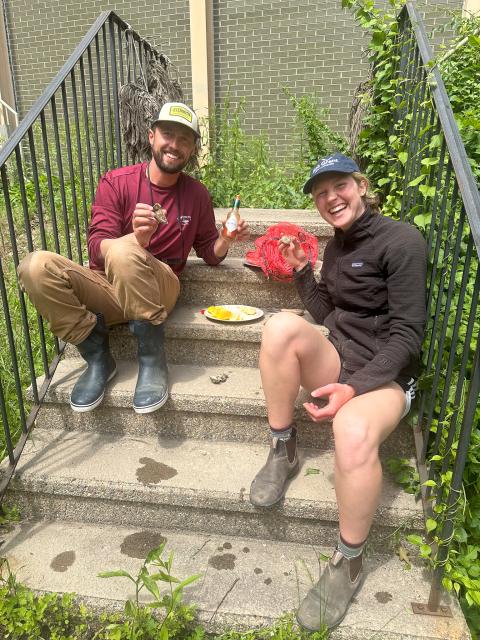
Emma sits with her mentor, Linas Kenter, enjoying some freshly shucked oysters together.
I’ve yet to come across someone unhappy with these collaborative programs. Farmers are compensated for the oysters they raise and harvest, thanks to USDA, TNC, and NRCS funding. While this is no get-rich-quick scheme, farmers often tell me what a relief it is to have a reliable source of income each year, independent of ever-changing markets, and a way to avoid wasting healthy, but funky-looking oysters.
Meanwhile, the partnership adds enormous capacity to restoration projects, with all of their associated benefits to the estuary. It also connects farmers with conservationists and the community in ways that breed collaboration, communication, and a stronger network of oyster supporters. In my book, those are the ingredients for environmental and community health: people who are passionate about what they do, programs mutually benefitting all kinds of different stakeholders, and active networks between them all.
It’s been a joy to be part of the network myself for the past couple of months. I’ve learned a whole lot, and I’m excited about what Sea Grant and its partners in the estuary are doing to help folks around the Great Bay have their oysters, and eat them, too!
Written by Emma Barker, 2025 Estuarine Aquaculture Research, Restoration, and Extension Doyle Fellow with New Hampshire Sea Grant.
Photos by Talia Katreczko, 2025 Coastal Science Communication Doyle Fellow with New Hampshire Sea Grant.
Learn more about oyster aquaculture in New Hampshire
